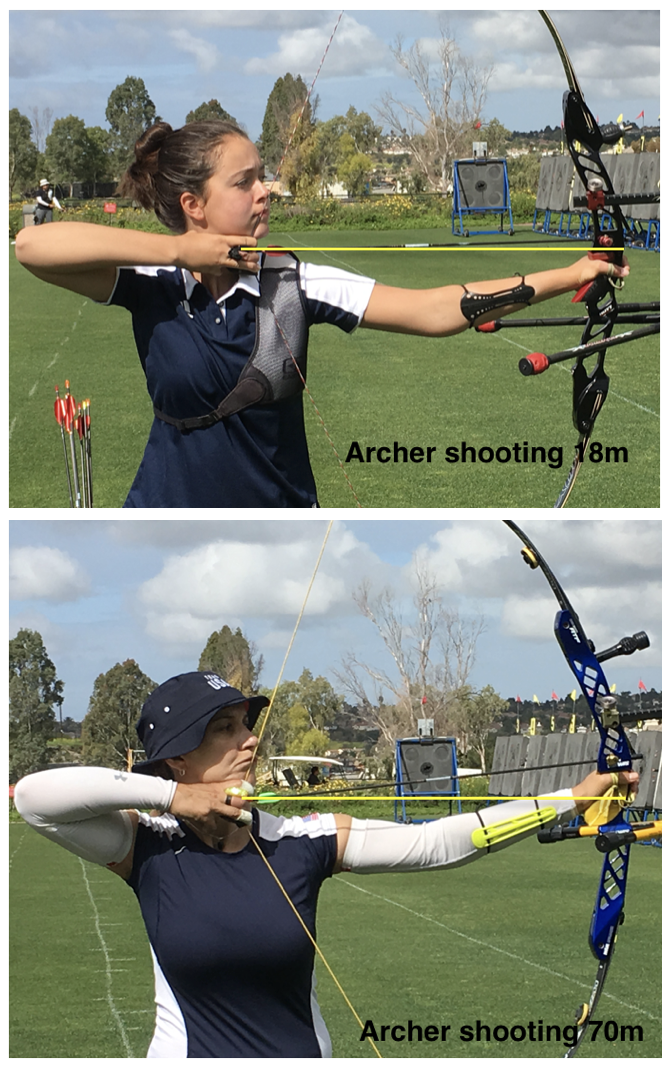Because of a full competition schedule and other external factors, archers sometimes have limited time to transition from indoors to outdoors. To make matters more difficult, archers living in northern regions may not have many opportunities to practice outdoors early in the outdoor season because of colder weather. One of the most critical factors affecting the transition is the feeling of aiming at a different angle. Over the course of the indoor season, archers get used to the feeling of aiming at an 18-meter target. This can make it difficult for the archer to transition to shooting longer distances because the body is conditioned to aiming at a lower angle.

This difference in angles can make it difficult for archers to have their sight slightly above the center of the target when they get to anchor. An even greater issue for compound, recurve, and barebow archers is the sight dropping below the center of the target. If the sight dips below the center of the target, the archer must work against gravity to raise the bow sight back up to center. Typically, this also puts force on the bow shoulder, causing it to rise. This, in turn, affects the archer’s draw length and ability to brace the bow.
Archers and coaches often try several unsuccessful means to fix this common issue. Attempts at correction may include removing weights on stabilizers, changing tiller and raising the bow hand higher at set up. Quite often, these Band-Aid fixes do not work for an extended period, and in return, archers are often left frustrated.
This issue is characteristically caused by the archer not maintaining the bow arm triceps tension as they draw to the Loading position. Biomechanically, the archer can address this common issue by maintaining the tension in the bow arm triceps as they draw from set up to the loading position. To begin with, the archer should focus on an external cue such as keeping their bow grip (or a watch or bracelet on their bow wrist) at the same height from set up to loading and anchor. Keeping the bow grip or bow hand at the same vertical position from set up, to loading and to anchor will keep the archer’s sight slightly above the center of the target.
Additionally, while transitioning from indoor to outdoor distances, the angle of the bow arm will FEEL very different and awkward. Archers can do a few things to speed up the amount of time it takes to make this angle feel more natural. Archers can position a target that is slightly elevated while shooting blank bale at 5 meters or less. The target should only be elevated 6-12 inches, maximum. Archers can put aiming dots on the elevated target that will replicate the same body angle as shooting the outdoor distance. Archers should verify that their sight is set for 5 meters and that their arrows will hit the target. Please note, shorter archers may need assistance in pulling arrows from an elevated target.
Archers can also practice at a target 5 to 10 meters further than the distance they normally shoot outdoors. When doing this, archers should move back gradually from their longest distance to insure they hit the target. Shooting 36 to 72 arrows at a target at a further distance than what is normally shot, provides a greater opportunity for adaptation. This will help speed the rate at which the normal distance will feel comfortable.
Summary
The transition from indoors to outdoors is critical, especially given the short time frame between competitive archery seasons. Keeping the sight just above the target through the shot process while coming to anchor is important in maintaining proper bone alignment, posture, and draw length. Focusing on an external cue such as maintaining the height of the bow grip is a simple cue that can help the archer keep the sight above the center the target through the shot process until anchor.
< Back to All News